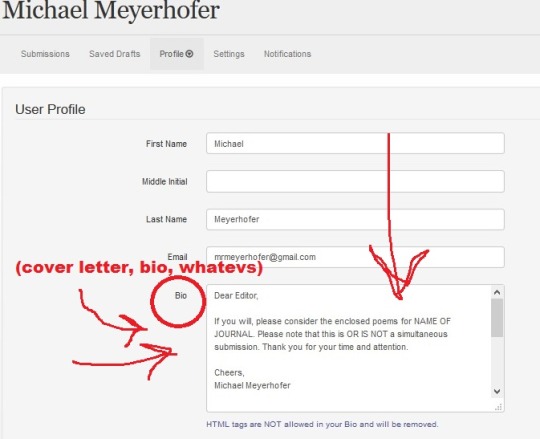But first, let’s talk about how to make your life easier…
It’s a good idea to keep a template for a cover letter saved somewhere on your computer. Remember, as I’ve mentioned before, it’s the general consensus among editors that cover letters should be short and sweet. After all, this is a cover letter, not an interview. Still, even if you have a template, cut and pasting your cover letter can be tedious, especially if you’re the kind of writer who sends of dozens or even hundreds of submissions. Luckily, Submittable has a feature had allows you to add a template cover letter, which will then be automatically added to every submission (though you can tinker with it before you send your work). Just click “profile”. Then, in the “Bio” box (which, admittedly, should be called something else), simply type your template cover letter.


So all I have to do is add the name(s) of the piece(s) I’m submitting in the “Title” box, tweak the Cover Letter to include the write names, and I’m good.

A growing number of writers have figured out how to amend their profiles so that their bios are automatically included in submissions, but then they submit their work without adding a cover letter. This means that when editors (like me) get a submission, all the “cover letter” box lists is their bio. Why is that bad? Well, for starters, it’s a good way to give an editor the impression that you know zero about their journal, and you’re really just shot-gunning submissions to as many journals with as little effort as possible.
Yes, simultaneous submissions are a good idea. No, editors are not gods who need their asses kissed. But if you’re going to ask someone to consider your work and possibly publish you, this is just the wrong approach. Remember the golden rule when it comes to cover letters: do no harm. Not even including one (unless the journal specifically instructs you to, which almost no journals do) definitely counts as causing harm in the eyes of most editors.
Another Bad Habit:
Maybe this is just me, but I consider it a professional courtesy to inform editors if my submitted work is under consideration elsewhere. That isn’t just a statement of honesty; it also lets the editor know that I checked their submission guidelines to make sure that simultaneous submissions are allowed at that particular journal, meaning that I know a little bit how this process work and I respect the editor’s time and attention.
Reading Fees:
This is where things get a bit contentious. While most journals (including Atticus Review) do not charge reading fees, a small number of journals do. How small? About three bucks. This is hardly earth-shattering (I spent less at the coffee shop where I sat down to write this), but some writers oppose such fees on principle, while others (myself included) have no problem with them. After all, it’s not like journals are raking in money hand over fist. Financially speaking, most journals are barely scraping by, and most editors (myself included) work FOR FREE. Reading fees are just a small pittance to help keep the lights on. Still, if you have an ideological objection, that’s fine. Submit elsewhere.
If your work is accepted…
…email the editor and thank them. After all, this is something of a partnership and as any couples therapist will tell you, no partner likes to feel unappreciated.
If your work is rejected…
…don’t send hate mail. Seriously. Don’t send hate mail! I get that you’re upset, but no matter how justified you think you are, you aren’t. Think of it this way: remember that time you asked somebody out, they said no, and you were disappointed? Well, did you immediately call them a bitch/asshole and try to make everyone else hate them? If the answer is yes, that’s probably why you’re having trouble getting a date.
If you sent work simultaneously, one of the poems gets accepted, and you need to withdraw it from other journals’ consideration...
...check the journal’s guidelines. Some journals want you to email them, informing them of the withdrawal. Others want you to withdraw the entire submission on Submittable, then resubmit from scratch with the accepted poem omitted. But most journals opt for an easier method: just add a note to the submission, visible to the editors, saying which poem is no longer available. To do this, click on the submission, then click “activity”, and add your note.

No comments:
Post a Comment